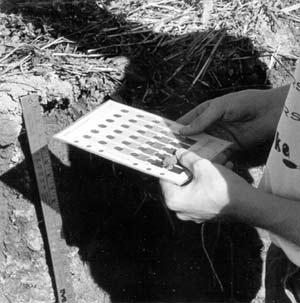II. SOIL AND LANDSCAPE PROPERTIES
Color Next Section>>
Soil color is important because it reflects or indicates several other important properties of the soil. In surface horizons, a dark color indicates high organic matter content. Organic matter, in turn, is responsible for many desirable physical and chemical soil properties. Compared to a soil with low organic matter, one high in organic matter takes up water faster, stores more water, is more resistant to erosion, has less tendency to form surface seals and crusts, and is easier to till. High organic matter soil also holds more plant nutrients.
In subsoil horizons, color reflects the natural drainage conditions and degree of development of a soil. For instance, in well and moderately well drained soils, soil development is indicated by more reddish or brownish colors in the B horizon than in the C horizon.
Grayish colors in the subsoil reflect wet soil conditions. In poorly drained soils the subsoils are dominantly gray. In somewhat poorly drained soils, the subsoils are dominantly brownish with gray mottles. Mottles are flecks or spots of one soil color in a background or matrix of another color (see Plate 14). The gray of a soil horizon is caused by reduction that occurs when the horizon is below the water table, thus saturated. Water tables are held up by very slowly permeable horizons that may be visible in a pit or may be deeper. In poorly and somewhat poorly drained soils, water tables may be near the surface in late winter and early spring but more than six feet deep in late summer and fall. Water table levels also vary greatly from year to year.
Subsections:Munsell Color System | Classes of soil color | Surface Color | Subsoil Color
Soil colors are determined by comparing the soil with standard Munsell soil color charts (Fig. 11). In that system, color samples are arranged according to three properties—hue, value, and chroma. Hue refers to the spectral color, or colors of the rainbow; value represents the degree of lightness or darkness of the color; and chroma represents the strength or purity of the spectral color. (See Chapter 7 for information about obtaining Munsell color charts and books).

Fig 11. Determining soil color using a Munsell card.
The system is best illustrated by looking at several pages from a Munsell color book. Hue is represented by numbers and letters like 10YR, 5R, 2.5Y, which indicate the spectral colors, such as Y for yellow, R for red or YR for a mixture of yellow and red. Different hues are on separate pages of the color book. Value changes up and down the page, with darker colors toward the bottom and lighter colors toward the top. Chroma is measured across the page, with neutral colors (black, gray, or white) to the left and more pure spectral colors (red,brown, yellow) to the right. The most commonly used chart in Indiana is for the 10YR hue. The next most common hues are 7.5YR which is redder than 10YR, and 2.5Y which is yellower, or more olive than 10YR.
back to topClasses of Soil Color
In soil evaluation, colors are divided into three classes (dark, gray, and brownish) which correspond closely to those used in soil classification. These classes are shown in Fig. 12 for the 10YR hue, but these same classes also apply to all hues. Some brownish colors may appear to be on the red side of brown (5YR and 2.5YR hues), and some may appear to be on the olive side of brown (2.5Y and 5Y hues).

Fig 12. Classes of soil color used in soil evaluation.
Print this Chart!
Click here for GIF
Click here for Word
Click here for PDF
back to top
Surface Color
In some surface horizons, the outside of a soil structural unit or ped
is a different color than the inside. In determining the color of the surface
horizon, official judges crush a moist soil sample between their thumb
and forefinger before determining soil color, and contestants should do
the same. Also, in some soils, especially those in grass, the color may
be darker at the surface than it is a few inches deeper. The convention
is to select a sample for color determination from the center of the surface
horizon. The official judges may also designate a depth at which to make
the determination, or, if the color is close to a boundary, they should
give the Munsell designation on the site card.
| To determine surface soil color, select a sample from the center of the surface horizon unless a different depth is listed on the site card. Crush moist soil material between your fingers and compare it with a Munsell color chart. Mark Gray, Brownish, or Dark on the scorecard according to Fig. 12. |
| Many Indiana surface horizons have colors between 10YR 3/3 and 10YR 4/3. If the color is near this class boundary, or other boundaries, official judges should give the Munsell designation on the site card. |
back to top
Subsoil Color
Subsoil color is used to determine natural soil drainage. Soil samples should not be crushed as they are for surface color. Instead, contestants should first look at the inside of a ped (or soil structural unit, see Fig. 6). To see the inside, they can break a ped apart, cut through it with a knife or spatula, or look at the face of the pit that has been cut with a spade (Fig. 13). Up to three colors should be noted: 1) the dominant or main color, 2) a minor color, if it is present; especially look for gray color, 3) clay films, if present. The depth of these colors is also important, as explained in the Natural Soil Drainage section.
back to top